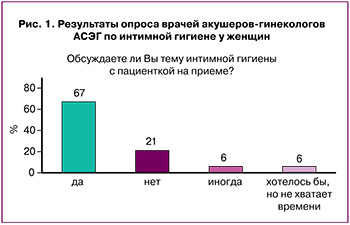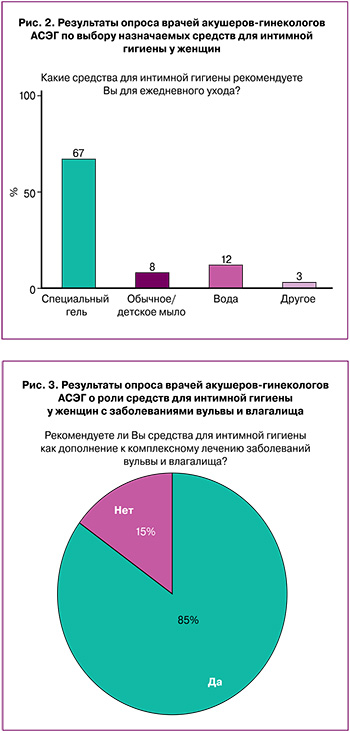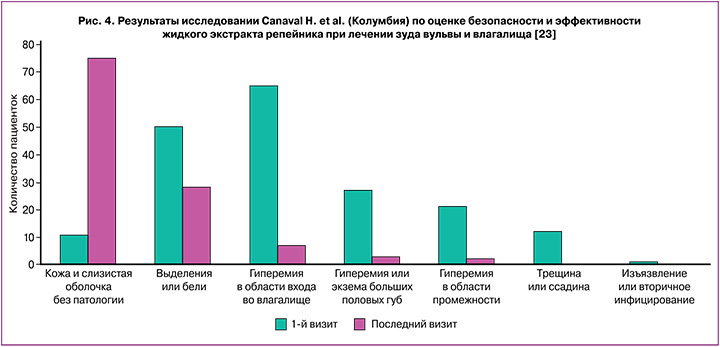21 апреля 2023 г. под председательством президента Российского общества акушеров-гинекологов (РОАГ) академика РАН В.Н. Серова и профессора, д.м.н. И.А. Аполихиной состоялся Экспертный совет, посвященный принципам интимной гигиены у здоровых женщин в различные возрастные периоды и при заболеваниях вульвы и влагалища. В совете приняли участие ведущие эксперты, клиницисты и ученые в области акушерства-гинекологии, дерматовенерологии, гастроэнтерологии и микробиологии. Группа ведущих экспертов обсудила ряд актуальных проблем, касающихся принципов интимной гигиены женщин, оптимизации методов лечения и профилактики вагинальных инфекций и бактериального вагиноза в современных условиях на основании обзора имеющихся международных и отечественных руководств и собственного клинического опыта. Также рассмотрены роль и место современных средств для интимной гигиены и эмолентов в правильной интимной гигиене.
Актуальность проблемы
В настоящее время одним из приоритетных направлений развития здравоохранения Российской Федерации являются медико-гигиенические мероприятия, направленные на формирование здорового образа жизни. К ним относится просветительская работа по формированию гигиенических навыков среди пациентов всех возрастных групп в целях профилактики воспалительных заболеваний органов женской репродуктивной системы. Стоит отметить недостаточную осведомленность женщин относительно вопросов этики интимного здоровья. Большая ответственность в отношении обсуждения и формирования правил личной гигиены у женщин ложится на врачей акушеров-гинекологов и дерматовенерологов амбулаторного звена [1]. Проведение просветительской работы позволяет сформировать правильные и адекватные гигиенические навыки у пациенток.
С учетом анализа данных литературы было продемонстрировано, что на сегодняшний день официально признанные рекомендации по интимной гигиене имеются лишь в некоторых странах (Бразилия, Португалия, Великобритания) и в большинстве своем отражают влияние на интимную гигиену многих факторов: индивидуальные предпочтения, культурные особенности, религиозные обряды, социальные факторы (в том числе, реклама) и, конечно, рекомендации медицинских работников. В Российской Федерации на сегодняшний день нет единых принятых принципов интимной гигиены.
Интимная гигиена – это не только определенные средства для гигиены наружных половых органов, это более широкое понятие, касающееся рекомендаций по образу жизни женщины, а также ее партнера.
Профессором Аполихиной И.А. был проведен опрос среди акушеров-гинекологов Ассоциации специалистов по эстетической гинекологии (АСЭГ), включающей более 1200 врачей, углубленно занимающихся заболеваниями вульвы и влагалища, с целью оценки информирования врачами своих пациенток о принципах интимной гигиены (рис. 1–3). Согласно полученным данным, только 1/3 врачей обязательно осматривают вульву на каждом приеме, более 60% врачей обсуждают правила интимной гигиены с пациентками (рис. 1). Из них 85% специалистов назначают специальные средства для интимной гигиены в дополнение к основному лечению (рис. 3), и только 67% делают акцент именно на щадящих средствах для интимной гигиены (рис. 2).


Анатомо-физиологические предпосылки правильной интимной гигиены
Для защиты внутренних половых органов женщины природа создала несколько барьеров на пути возбудителей заболеваний. С анатомо-физиологической точки зрения именно вульва представляет собой первый барьер на пути патогенных факторов. Прежде всего это анатомические особенности девочки, а именно девственная плева, которая играет защитную роль. В области преддверия влагалища расположены устья протоков парауретральных желез, многочисленных больших и малых желез преддверия, которые обеспечивают увлажненность вульвы и влагалища, создают благоприятные условия для естественной флоры. Кожа, сама по себе представляющая барьерный орган и образующая большие половые губы, содержит значительное количество потовых и сальных желез, вырабатывающих секрет с противомикробным эффектом. Большие железы преддверия (бартолиновы) расположены в основании больших половых губ на глубине около 1 см. При их инфицировании образуются кисты, в которых в дальнейшем могут развиться воспаление и нагноение, требующие оперативного лечения. Воспалительным процессам подвержены и малые железы преддверия, выстланные цилиндрическим однорядным эпителием, секретирующим слизь. К механизмам физиологической защиты вульвы и влагалища относятся естественная десквамация эпителия и влагалищные выделения. При этом следует отметить, что кожа вульвы имеет нейтральный рН.
Вагинальный секрет – это серозный транссудат крови через стенку влагалища, секрет желез слизистой оболочки цервикального канала и больших желез преддверия влагалища, он содержит лейкоциты и клетки слущенного эпителия. Таким образом, влагалищные выделения имеют физиологический характер и являются абсолютной нормой для здоровой женщины, что и определяет особенности интимной гигиены. Для здоровья женщины важно, чтобы во влагалище сохранялась кислая среда с рН 3,5–4,5. В норме микрофлора влагалища на 95% состоит из лактобацилл, которые продуцируют молочную кислоту. Именно кислая среда является основным естественным барьером влагалища. Смещение рН в щелочную сторону создает благоприятные условия для размножения патогенных микроорганизмов, что довольно часто может быть связано с агрессивной интимной гигиеной (вагинальные души, спринцевание, применение вагинальных дезодорантов, кремов для депиляции, ежедневных прокладок и др.).
Помимо этого, дестабилизация влагалищной экосистемы может быть вызвана рядом факторов, обусловленных урбанизацией населения, неблагоприятным воздействием окружающей среды, а также образом жизни: курением, использованием ежедневных прокладок, ранним началом половой жизни и беспорядочными половыми связями, тотальной эпиляцией зоны бикини, бесконтрольным применением лекарственных препаратов, особенно антибиотиков, противогрибковых препаратов и контрацептивов, несоблюдением правил интимной гигиены или же, наоборот, чрезмерной гигиеной (в том числе частым мытьем мылами с большим количество поверхностно-активных веществ (ПАВ)). Интимная гигиена должна прежде всего не нарушать естественный баланс. Следует отметить, что интимная гигиена прежде всего касается гигиены области вульвы. Недостатками большинства средств интимной гигиены являются: неудовлетворительный уровень рН, содержание агрессивных ПАВ, антисептиков, мыла и др. Это может повлечь за собой изменение рН вульвы и влагалища, снижение увлажнения и, как следствие, нарушение состава микробиоты. В связи с этим актуальным является обоснование составов средств для интимной гигиены не только с технологической, но и с медицинской точки зрения. Доказано увеличение частоты бактериального вагиноза (БВ) и кандидозного вульвовагинита (КВВ) в связи с агрессивной интимной гигиеной [2–12].
Стоит уделить особое внимание интимной гигиене женщин в постменопаузе с признаками вульво-вагинальной атрофии – распространенным состоянием, связанным со снижением эстрогенизации урогенитального тракта. Симптомы включают сухость влагалища, раздражение, зуд, болезненность, жжение, диспареунию, учащенное мочеиспускание и ургентность. Неадекватная интимная гигиена с применением агрессивных средств может усугубить течение атрофического процесса и значительно снизить качество жизни женщины.
Дерматологи и гинекологи также отмечают рост частоты встречаемости дерматозов аногенитальной зоны, например, в отделение эстетической гинекологии и реабилитации НМИЦ АГП им. В.И. Кулакова Минздрава России за 2014–2019 гг. обратились 138 пациенток в возрасте от 20 до 72 лет с заболеваниями вульвы, из которых 62,8% страдали зудом и жжением, обусловленным дерматозом вульвы (склерозирующим лихеном). Вопрос интимной гигиены как неотъемлемой части терапии и профилактики осложнений данных заболеваний, облегчения симптомов зуда являются наиболее актуальными [5].
Современные средства для интимной гигиены
Женщины во всем мире регулярно пользуются средствами интимной гигиены в своих ежедневных рутинных гигиенических процедурах. В настоящее время существует множество различных средств интимной женской гигиены, которые можно использовать для поддержания чистоты наружных половых органов и/или борьбы с запахом, но некоторые из них могут изменять нормальный уровень рН и микробиоту, необходимую для защиты от инфекции. Несмотря на то что существует большое количество публикаций о влиянии гигиены на рН и микробиоту влагалища, довольно ограниченное количество информации представлено о влиянии средств интимной гигиены именно на вульву. Поэтому просвещение населения о важности женской интимной гигиены и потенциальных рисках, связанных с ней, является важным приоритетом как для медицинских работников, так и для самих женщин в целях профилактики заболеваний урогенитального тракта.
Для гигиены наружных половых органов рекомендуется использование специальных средств, поддерживающих нормальный уровень pH вульвы и естественный уровень увлажнения. Синтетические моющие средства в целом являются оптимальным выбором для всех типов кожи, в том числе и аногенитальной зоны, если их pH соответствует pH кожи и они не нарушают кожный барьер и микрофлору [13–17].
Важным критерием выбора средства для интимной гигиены является отсутствие негативного влияния на кислотно-щелочной баланс вульвовагинальной области для сохранения естественной микробиоты и предотвращения размножения патогенных микроорганизмов, а также нарушения гидролипидного слоя кожи.
Щелочные мыла, применяемые для гигиены и известные человечеству за 300 лет до н.э., могут повреждать белки, липиды и компоненты натурального увлажняющего фактора рогового слоя эпидермиса, в отличие от синтетических моющих средств, не разрушающих белковые и липидные пласты рогового слоя эпидермиса кожи. Потенциальная способность мыла нарушать барьерную функцию, вызывать сухость и раздражение кожи склоняет чашу весов в сторону его неблагоприятных эффектов, в связи с чем не рекомендуется применять мыла для интимной гигиены.
При этом гигиена наружных половых органов только водой не всегда достаточна для предотвращения размножения патогенных и коменсальных форм бактерий, с учетом анатомической близости ануса [16–22].
Экспертами была рассмотрена линейка средств для интимной гигиены на основе экстракта корня репейника «Сафорель» (Biocodex, Франция):
- гель для интимной гигиены БЕРЕЖНОЕ ОЧИЩЕНИЕ, который может применяться ежедневно и подходит для всех возрастных периодов жизни женщины;
- гель для интимной гигиены ИНТЕНСИВНОЕ УВЛАЖНЕНИЕ, который рекомендуется применять при сухости и зуде области вульвы, интенсивно увлажняет, уменьшая ощущения сухости и стянутости кожи;
- крем-эмолент увлажняющий для интимной зоны на основе натурального экстракта корня репейника, аллантоина и сока листьев алоэ вера, который возможно применять в качестве эмолента для увлажнения кожи наружных половых органов, восстановления ее гидролипидного слоя, подходит для чувствительной раздраженной кожи интимной зоны для ежедневного ухода.
Входящие в состав линейки средств «Сафорель» для интимной гигиены экстракт корня репейника и сок листьев алоэ вера обладают рядом терапевтических свойств. Так, в исследовании Canaval H. et al. (Колумбия) по оценке безопасности и эффективности жидкого экстракта репейника в качестве дополнительного средства при лечении зуда вульвы и влагалища (рис. 4) были продемонстрированы его высокая терапевтическая эффективность и быстрое облегчение зуда, уменьшение гиперемии [23, 24].

Подобные результаты наблюдались в исследовании Berlier P. (Франция) [25]: при использовании 1,2% экстракта репейника у девочек отмечалось уменьшение белей, зуда и гиперемии в области вульвы. В то же время при применении 1,2% жидкого экстракта репейника в различных исследованиях отсутствовали побочные эффекты, отмечалась хорошая переносимость со стороны кожи и слизистой оболочки влагалища. Также считается, что действующие вещества обладают нейтрализующим действием в отношении раздражения нервных окончаний на коже и слизистых оболочках, а также меняют величину pH, что тормозит рост оппортунистической грибковой флоры в области вульвы и промежности. Следует отметить, что фармакологический эффект репейника отмечен Французским агентством лекарственных средств и изделий медицинского назначения (AFSSAP) в бюллетене «Лекарственные средства на растительной основе», который включает следующие указания для листьев репейника (местное применение): «традиционно используется как дополнительное средство для местного применения со смягчающим и противозудным эффектом при поражениях кожи».
Препараты алоэ широко применяются в медицинской и фармацевтической практике в настоящее время. Из алоэ готовят сок алоэ, линимент алоэ, сироп алоэ с железом, экстракт алоэ жидкий для инъекций. Очень широкое применение гель алоэ вера нашел в косметической промышленности, в качестве увлажняющего и смягчающего средства. Кремы с алоэ можно найти в различных продуктах для кожи, используемых для заживления ран и в косметических целях. Препараты алоэ обладают очень выраженными лечебными свойствами, такими как антибактериальное, биостимулирующее и биорегенерирующее, ранозаживляющее и противовоспалительное. В эксперименте на животных экстракт биостимулированных листьев алоэ повышал иммунные свойства организма подопытного. Таким образом, биостимулятор, который был получен из листьев алоэ, дал новое направление для применения растений алоэ в медицинской практике. Значимый фармакотерапевтический эффект алоэ объясняли входящими в состав витаминами и минеральными веществами, которые активировали защитные свойства организма [26].
По результатам фиксированных выступлений и дискуссии в рамках Совета экспертов был сформулирован тезис о том, что мягкая, не содержащая мыла моющая основа, обогащенная смягчающими и увлажняющими веществами, линейки средств «Сафорель» отвечает всем требованиям к средствам для гигиены интимной области. А содержащиеся экстракт корня репейника и сок листьев алоэ вера обладают лечебно-профилактическими свойствами, позволяющими рекомендовать их в том числе женщинам с заболеваниями аногенитальной области.
Рассмотрев предложения ведущих специалистов России в области акушерства-гинекологии, дерматовенерологии, гастроэнтерологии и микробиологии, Совет экспертов решил следующее.
1. Тема интимной гигиены не получила достаточного освещения в медицинской литературе и СМИ, что делает ее просвещение приоритетным направлением в работе акушеров-гинекологов и дерматовенерологов.
2. Нет систематических обзоров и РКИ по оценке влияния гигиены наружных половых органов на здоровье, что определяет необходимость проведения таких многоцентровых научных исследований командой специалистов. На основании полученных данных, зарубежных клинических рекомендаций и имеющихся литературных обзоров актуально создание раздела по принципам интимной гигиены при пересмотре клинических рекомендаций по БВ, менопаузе и климактерическим состояниям у женщины, воспалительным болезням шейки матки, влагалища и вульвы, профилактике ИППП.
3. Формирование навыков правильной интимной гигиены во всех возрастных периодах жизни женщины является важным звеном профилактики инфекционно-воспалительных заболеваний женской репродуктивной системы. Целесообразно также информировать мужчин о навыках и принципах мужской интимной гигиены, имеющей непосредственное влияние на репродуктивное здоровье женщины.
4. Важна надлежащая женская интимная гигиена с использованием должным образом разработанных и протестированных продуктов с ключевыми характеристиками, учитывая анатомо-физиологические особенности вульвы и влагалища: гипоаллергенность, отсутствие мыла, раздражающих веществ и антисептиков, pH-безопасность (в диапазоне от 4,5 до 9). Щелочная среда предусмотрена как дополнение в комплексе наружного лечения микозов, защиты от сухости и поддержания сбалансированной микрофлоры.
5. В связи с вышеперечисленными фактами экстракт корня репейника представляется эффективной и безопасной основой средств для интимной гигиены «Сафорель» компании BIOCODEX (Франция). Применение средства с репейником успокаивает, снимает раздражение и смягчает, а также эффективно для быстрого облегчения зуда и признаков воспаления. Поскольку ненадлежащая интимная гигиена может быть одним из факторов развития БВ и КВВ, рекомендовано применение в качестве как профилактики нарушения баланса интимной зоны, так и дополнения в составе комплексной терапии БВ и КВВ, а также профилактики рецидивов.
6. При дерматозах аногенитальной области интимная гигиена имеет особенности и является важным этапом лечения и профилактики обострений заболевания: щадящие увлажняющие средства для гигиены, обязательное применение эмолентов после каждой гигиенической процедуры. Рекомендуется тщательно подбирать средства ухода за вульвой и обязательно информировать пациенток о принципах их применения.



